Introduction
Childhood-onset systemic lupus erythematous (cSLE) is a life-long autoimmune disorder characterized by higher disease severity and multisystem involvement as compared to adult-onset disease.1 This is commonly due to the higher…

Childhood-onset systemic lupus erythematous (cSLE) is a life-long autoimmune disorder characterized by higher disease severity and multisystem involvement as compared to adult-onset disease.1 This is commonly due to the higher…
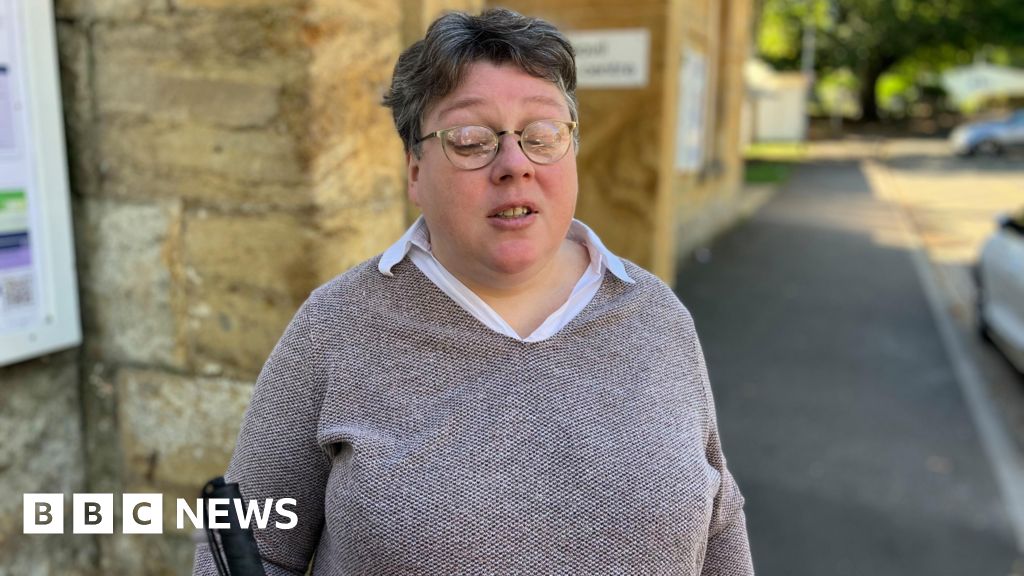
Ruth BradleyPolitics reporter, BBC Somerset, Yeovil
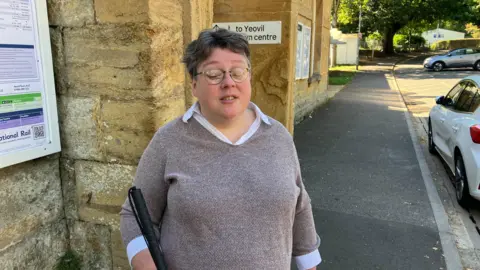 BBC
BBCA severely visually-impaired woman said she crossed railway tracks alone to catch a train, after station staff she had booked to help her did not turn up.
Kath Vickery has now started a petition to improve assistance arrangements after feeling “too anxious” to use her local station – Yeovil Pen Mill in Somerset – following the “really scary experience”.
Great Western Railway (GWR) apologised and said it was exploring how to “deliver more robust staffing”.
Figures show 10 out of 62 stations (16%) across the West of England have either no step-free access or issues with at least one platform. The Department for Transport said improving accessibility is “at the centre” of its decision-making.
Ms Vickery uses a cane and needs assistance when navigating railway stations. She said the incident happened in August 2024 – although she only started her petition recently after other more minor incidents.
Yeovil Pen Mill has a stepped footbridge to get to one of its platforms, but staff are able to help people across the tracks using a private level crossing reached by a ramp, if needed.
“When I got there I was a bit stuck because the ticket office was shut and that’s usually where I find staff,” she said.
“I didn’t feel comfortable going across the bridge on my own. I walked down to the track crossing in the hope someone would help.
“I rang the passenger assist call centre, I had a 13-minute conversation with them – they accidentally cut me off transferring me to someone – in the end I managed to attract the attention of someone at the station who told me I could cross, so then I had to run across the track crossing and up the platform to get my train.
“It was a really scary experience for me and obviously not great for safety, and still really affects me now.”
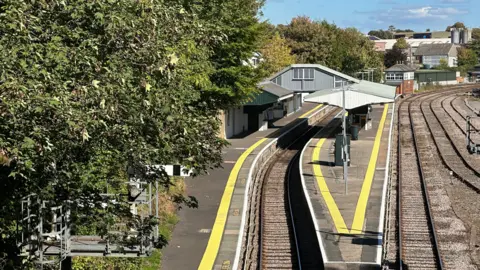
Passenger assistance can be booked in advance for rail journeys – by phone, online or using an app – and is confirmed with the passenger
When assistance has been booked, if staff are then unable to fulfil that, the passenger is meant to be informed and GWR said it offers alternatives including a free taxi to the nearest accessible station.
Staff are meant to be available at Yeovil Pen Mill from 07:20 to 18:25 on weekdays, other than a lunch break, with shorter hours at weekends.
Ms Vickery used to use the station every week or two to get to medical appointments and ad hoc self-employed work in Bristol and Weymouth.
She said she has recently had to turn down work in Weymouth as she felt unable to rely on the assistance she would receive at Yeovil Pen Mill.
Ms Vickery said losing the option of using the railway station long-term would be a “disaster” for her, with the only alternative to Bristol being a three-hour bus journey.
“It’s not like I’ve got the choice between driving and catching a train – the choices I have are very, very limited and that’s why making sure the station is staffed its scheduled hours is so very important to me,” she said.
She said she had two cancellations of assistance in the last year in addition to the experience in August 2024 when she was not informed the station would be unstaffed.
“I think it’s really important that disabled people have equal opportunity to use services and that includes train stations – and in order to use the train station I need there to be staff there,” Ms Vickery said.
A spokesperson for GWR said: “We recognise that staffing gaps during holiday periods have impacted advertised opening hours at Yeovil Pen Mill, and we apologise for any inconvenience this causes passengers like Kath who rely on staff assistance.
“While our dedicated team works hard to maintain coverage, we know that we need to increase the staff relief pool to consistently staff all stations during peak leave periods, and we’re exploring opportunities to deliver more robust staffing.”
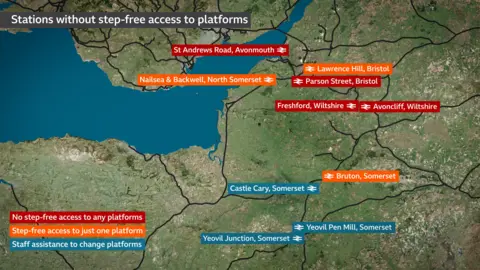
According to the disabled-led campaign group Transport for All a quarter (25%) of UK train stations have step-free access with 11% of stations staffed at all times.
Of Somerset’s 10 national rail stations, four (40%) do not have step-free access to all platforms, which can be used independently of station staff, according to information listed on the National Rail website.
For example, Castle Cary station, on the Paddington mainline, has a stepped footbridge to the westbound platform meaning passengers need staff available to help them across the tracks.
Across the West of England, 10 out of 62 stations (16%) have either no step-free access, like Avoncliff and Freshford in Wiltshire, or issues with at least one platform.
Nailsea and Backwell station, which has steps to one platform and a very steep slope to the other, was due to have had ramps installed at both platforms more than 10 years ago but £1m funding was withdrawn in 2014 after a deadline to start the work was missed.
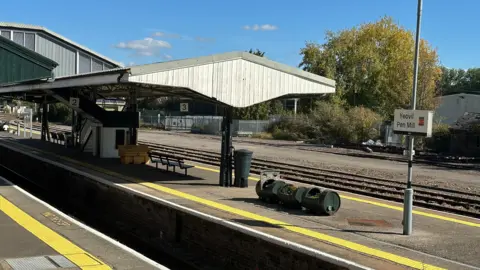
A spokesperson for the Department for Transport said it was “taking action to make rail travel easier and more reliable for disabled passengers”.
They added this included investing more than £10m to upgrade the Passenger Assist scheme, publishing a rail accessibility roadmap and improving information about the facilities available to provide support to passengers at stations.
Image used for representation
| Photo Credit: The Hindu
Actor Priyanshu alias Babu Ravi Singh Chhetri, who became famous for his onscreen…

 ELLEN KNIGHT/BBC
ELLEN KNIGHT/BBCA man who was diagnosed with early-onset dementia at the age of 42 has raised more than…

Felicity Kvesicin Bromsgrove
 Natalie Morris
Natalie MorrisThe family of a rugby player who died 18 months after he was diagnosed with motor neurone disease (MND) have said the…

Fortnite players who are eager to jump into and play in their favorite modes might be facing some temporary connection disruption. If you are receiving error messages or are…

Giannis Antetokounmpo: ‘I’ve always wanted to be in Milwaukee, always wanted to represent the city, as long as we have the opportunity to win.’
MILWAUKEE (AP) — Giannis Antetokounmpo reaffirmed that he’s “locked in” with the…

Sophie CridlandSouth of England
 BBC
BBCYoung people have said the social pressure to have a smartphone has made them “almost essential”.
In February 2024, Ofcom reported that nine out of 10…
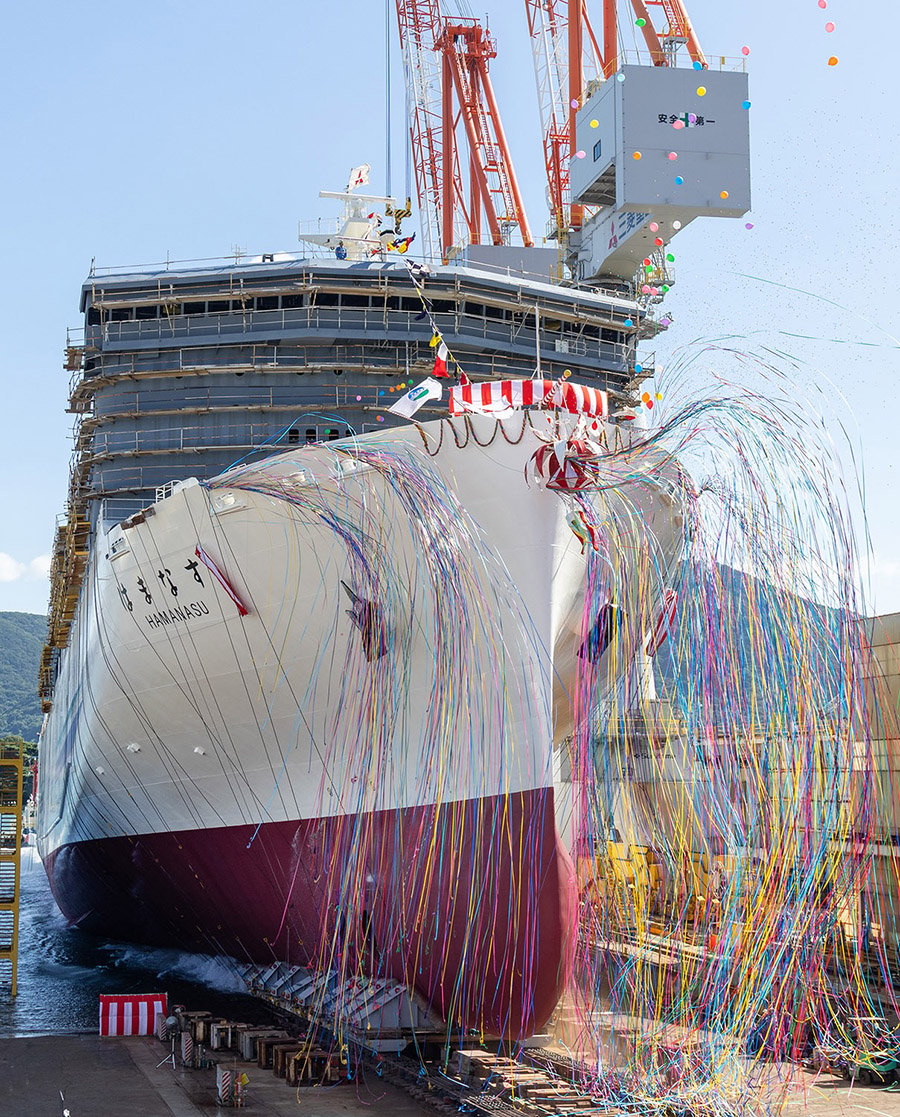
Christening and Launch Ceremony of HAMANASU
Tokyo, October 9, 2025 – Mitsubishi Shipbuilding Co., Ltd., a part of Mitsubishi Heavy Industries (MHI) Group, held a christening and launch ceremony on October 9 for the second of two large car ferries ordered by Shinnihonkai Ferry Co., Ltd. and Japan Railway Construction, Transport and Technology Agency (JRTT). The ceremony took place at the Enoura Plant of MHI’s Shimonoseki Shipyard & Machinery Works in Yamaguchi Prefecture. The new ferry will serve on a shipping route between the cities of Otaru in Hokkaido and Maizuru in Kyoto Prefecture.
At the ceremony, Shinnihonkai Ferry President Yasuo Iritani christened the new ferry “HAMANASU,” the Japanese word for a species of native shrub rose. The ceremonial rope cut was performed by Nozomi Kobayashi, ship travel ambassador for the Japan Passengerboat Association. The ship’s handover is scheduled for June 2026 following completion of outfitting work and sea trials. The HAMANASU is the tenth ferry built by Mitsubishi Shipbuilding for Shinnihonkai Ferry.
The HAMANASU utilizes the latest energy-saving vessel design, including being one of the second ferries in Japan to incorporate a buttock-flow stern hull(Note1) and a ducktail,(Note2) along with a KATANA BOW. Propulsion resistance is suppressed by an energy-saving roll-damping system combining an anti-rolling tank(Note3) and fin stabilizers,(Note4) providing energy savings of 5% compared to conventional ships.
The christening and launch ceremony for the first ship ordered by Shinnihonkai Ferry and JRTT, named KEYAKI, was held in April 2025, with handover scheduled for November.
Japan is currently undergoing a modal shift to sea transport to mitigate environmental impacts by reducing CO2 emissions, and to compensate for truck driver shortages arising from workstyle reforms. This shift has brought utilization of ferry transport into sharp relief. Going forward, Mitsubishi Shipbuilding will continue to contribute to the active use of sea transport and environmental protection, resolving diverse issues together with its business partners through construction of ferries that provide stable sea transport together with outstanding energy and environmental performance.
■ Main Specifications of the HAMANASU
| Ship type | Passenger-carrying car ferry |
|---|---|
| LOA | Approx. 199m |
| Beam | Approx. 25.5m |
| Gross tonnage | Approx. 14,300t |
| Service speed | Approx. 28.3 knots |
| Passenger capacity | 286 |
| Loading capacity | Approx. 150 trucks and 30 passenger cars |